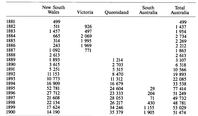


Chapter 2
I Technology Transported; 1788-1840
II Technology Established; 1840-1940
i Meat Preserving: Heat Processing Introduced
ii Horticultural Products: Heat, Sugar and Solar Drying
iii Refrigeration and the Export of Meat
iv Milling and Baking
v Dairy Products
vi Beverages
vii Sugar: Supplying an Ingredient
III The Coming Of Science
IV From Science To Technology: The Post-war Years
V Products And Processes
VI Conclusion
VII Acknowledgements
References
Index
Search
Help
Contact us

Refrigeration and the Export of Meat [51] (continued)
Mort introduced the cooling of milk for transport from country to city and by 1875 had established a refrigeration plant for meat at Bowenfels in the Blue Mountains and refrigerated warehouses for the reception of this meat at Darling Harbour in Sydney. These were major advances in the refrigerated handling of foods.[56] In 1877, refrigeration machinery was installed in the ship Northam. It worked well but there were delays because of some corrosion problems and eventually the ship sailed without its planned consignment of frozen meat. This was a bitter blow to Mort and he died in 1878 without ever seeing the shipment of refrigerated meat to England.In 1876, the French had successfully shipped chilled meat from South America to Europe using an ether refrigerator and in 1878 a small cargo held frozen by ammonia compression refrigeration was lifted from Argentina to Le Havre. This stimulated the interest of a group of Queenslanders. one of whom, Mr. (later Sir) Thomas McIlwraith, asked his brother to go to Le Havre and look at the French vessel, S.S. -Paraguay. The result was that a steamer engaged in the Atlantic trade, S.S. Strathleven, was chartered, fitted with Bell and Coleman (of Glasgow) air compression/expansion refrigeration equipment, and sent to Australia for a trial shipment of frozen carcases. The meat, and some experimental kegs of butter, were loaded from chill rooms in Sydney and Melbourne and, freezing the consignment on board, Strathleven left Melbourne on 6 December 1879 and arrived in London on 2 February 1880. Technical men travelled on the ship to oversee the trials and the voyage was well documented.[57] The meat was in excellent condition on arrival and sold well. In all ways this first shipment of frozen meat from Australia was a success, but the credit lay with Andrew McIlwraith and refrigeration equipment which was commercially available. It is surprising that the equipment was at once stripped from the ship and the Strathleven returned to its normal Atlantic service.
In Australia, even before the Strathleven had arrived in London, plans were afoot to form a company to export frozen meat and in April 1880, the Australian Frozen Meat Export Company was organized in Melbourne. Temporary freezing facilities were rented from the Melbourne Meat Preserving Company until substantial freezing works were built at Newport. The S.S. Protos was chartered, fitted with refrigeration machinery and the chamber insulated with wool which was sold at a profit in London. It sailed on 18 November 1880 with lamb, mutton, and butter all of which arrived safely in England in January 1881.
This promising start was well received in London, where refrigerated stores for the reception of such cargoes had been established. The major impediment, however, and as it turned out a very serious one for the Australian Frozen Meat Export Company, was lack of sufficient shipboard refrigerated space. The Orient line fitted out three vessels for refrigerated cargoes but the P & 0 company hesitated and it was even suggested that this was not unconnected with a desire to protect those who were involved in the English meat industry. Be that as it may, one can see the dilemma; on the one hand, hesitation by the shipowners to install refrigerated space without long term contracts, and on the other, hesitation by exporters to enter into the latter without some guarantee of lower cargo rates. It was not until the mid-nineties that government interventions solved the problem (Cf. total exports for 1894 & 1895, Table 1).

Tons
From: K. T. H. Farrer, A Settlement Amply Supplied, p. 250 amended.
Organisations in Australian Science at Work - Australian Frozen Meat Export Company, Melbourne; Melbourne Meat Preserving Company, Vic.
People in Bright Sparcs - McIlwraith, Mr (later Sir) Thomas; Mort, T. S.
 |
Australian Academy of Technological Sciences and Engineering |  |
© 1988 Print Edition pages 92 - 93, Online Edition 2000
Published by Australian Science and Technology Heritage Centre, using the Web Academic Resource Publisher
http://www.austehc.unimelb.edu.au/tia/090.html